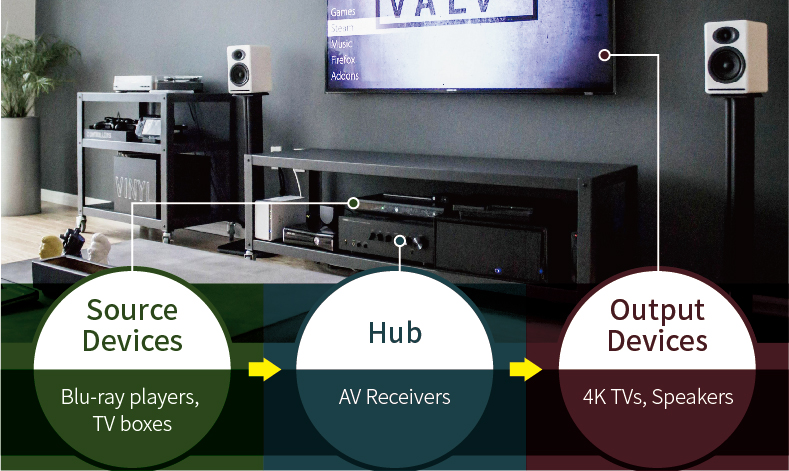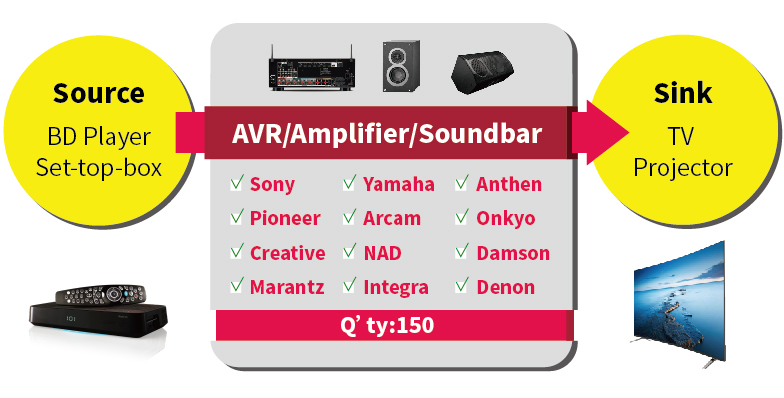A New Way to Experience Sound: Experience Dolby Atmos on Mobiles
Thanks to the invention of Home Theater, we can now easily enjoy entertainment at home. This absolutely makes our lives more convenient as we can sit comfortably on our couches with popcorn and snacks on one hand, and choose any movie that we want to watch at any time.
Home Theater ecosystem is developing at an unprecedented speed, and we are seeing drastic growth in both audio and visual technologies that bring users better watching experiences. Today we are going to focus on the sound experience of home theaters by introducing Dolby Atmos and its two key applications, and how Allion’s Atmos Ecosystem can help vendors verify and validate their Dolby-supported devices. Dolby Atmos nowadays can be found not only in many cinemas and home theater systems, but also on PCs, gaming, streaming Apps, and even mobile phones.
With Dolby Atmos on mobile devices, we literally can enjoy decent sound quality movies and games anywhere, anytime.

We know that Dolby Atmos for Home (with 7.1.2 channels) creates the bouncing sound with overhead or ground speakers. This is different from traditional sound systems as they only adopt a few channels, front, right, back, left to create sound flows. More complex systems like Dolby Atmos treats audio as objects and replaces channel dependency, meaning that users can deploy as many speakers as they have and assign them in any place, and by installing overhead and ground speakers, the sound literally flows in a three-dimensional place, thus creating a very lifelike, immersive sound experience for audiences.
So some of you might be wondering, how is it possible to get a full surround audio on our phones without the overhead speakers? This is how Dolby Atmos for Mobile works: Dolby Atmos Laboratories utilizes two key components to realize flowing sound on mobile devices.
1. Psychoacoustics: simulate how human perceive various sounds
2.HRTF(Head-Related transfer Function): a transfer function that transforms sounds and affects how ears positions sounds in the three dimensions and perceive and attenuate frequencies.
There are many new launched mobiles phones that support Dolby Atmos surround sound. Check out the list here: Mobile with Dolby.
And the setup of Dolby Atmos is not so difficult. Using Brand S as an example, next we are going to walk you through the setting of Dolby Atmos on mobile phones. First, go to setting and click on “sound and vibration”, and then click on “sound quality and effects” to turn on Dolby Atmos. Once the setting is completed, you may plug in your headphones and enjoy your music, video, or games.
After a brief overview of Dolby Atmos for Mobile, we are going to introduce to you our test on Dolby Atmos on three different phones. For this test, we need different earphones (including over-ear, earbuds, and Dolby Atmos-supported earphones). And our audio expert is going to conduct careful sound quality checks on the three different phones to generate an in-depth review report, which serves as an important reference for consumers, as well as valuable information for vendors.

So which phone is the better deal?
The chart above was excerpted from our original report. As you can see, Model A from Brand S has a much weaker performance compared to Model B of Brand S or Brand H in terms of all kinds of sounds. We think Brand S is plagued with software issues and we still need further verification and validation from Allion’s Software Testing Lab for further analysis.
After conducting the test, we learn that the performance of Dolby Atmos varies on different phones. However, issues do not only occur on mobile phones, other sound devices, for instance home theater systems with Dolby Atmos might also have the same issues.
To learn what issues might occur on a home theater system, first we have to know what a home theater is consists of:

As more film production companies plunge into making Dolby Atmos films, more vendors are launching Dolby Atmos-enabled devices to enrich the ecosystem and meet the market’s demand. And for the AV receivers that act as the central hub to connect every piece of A/V gear are the keystones to the development and quality of the home theaters. But, as the ecosystem flourishes, it will encounter some of the most challenging issues— interoperability and compatibility between the devices.
Interop issues of Dolby Atmos and how to solve them
To solve all kinds of interoperability issues, it is important to unveil the root cause by pairing different products in different scenarios. The three common user scenarios are as follows:
Scenario 1. Player >A/V Receivers (Integrate audio decoding and audio amplification technology) > Speakers
Scenario 2. Player > Pre-amp decoder (with decoding function only) > Amplifier (with amplifying function only) > Speakers
Scenario 3. Player > Pre-amp decoder (only has decoding functions) > Active speakers (built-in amplifier)
In scenario 1, consumers only need to buy one AVR to connect source and output devices. It is the most convenient and common user scenario. Scenario 2 or 3 are specifically designed for the high-end home theater market where needs both decoders and amplifiers at once. There’s a great variety of combinations of scenarios.
Allion builds the Dolby Atmos ecosystem, formed by all kinds of source devices, output devices, and the hub devices, such as AVR, Amplifier, and Soundbar. And our pool for the amount of those mainstream hub devices has reached 150 quantities, arguably topping the industry (see picture below).

Get Hold of Dolby Atmos and Dolby Surround
With Dolby Atmos Ecosystem, Allion has the necessary testing equipment to conduct tests on Dolby Atmos 7.1.2 (with overhead soundbars) and Dolby Surround 7.1 (without overhead soundbars). Allion Labs assures the quality of your Dolby-supported devices in terms of interoperability, stability, functionality, and connectivity. We also strive to enhance the overall user-experience with careful testing, verification, and validation in the product developmental stage. This will lower consumer complaint rate and allow vendors to save time in after-sales services and the cost for exchange and refunds.
Within Dolby Atmos Ecosystem built up with abundant resources, Allion can conduct tests on both Dolby Atmos 7.1.2 (with overhead speakers) and Dolby Surround 7.1 (without overhead speakers). Allion Labs assures the quality of your Dolby-enabled devices in terms of interoperability, stability, functionality, and connectivity. We also strive to enhance the overall user-experience with careful testing, verification, and validation in the product developmental stage. This will significantly lower consumer complaint rate and allow vendors to save time in after-sales services and the cost for exchange and refunds.
Dolby Atmos is a surround sound tech launched by the Dolby laboratories in April, 2012. The Dolby Atmos was a breakthrough in audio technology as audio elements are treated as a sound object instead of channels. This allows users to create a flowing sound effect in a three-dimensional place, creating an even more realistic and immersive sound experience.







































